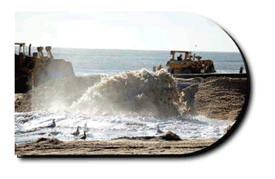Our Shore Protect Team Diaries
Not known Facts About Shore Protect Team
Table of ContentsWhat Does Shore Protect Team Mean?How Shore Protect Team can Save You Time, Stress, and Money.The Definitive Guide to Shore Protect TeamThe Ultimate Guide To Shore Protect Team10 Simple Techniques For Shore Protect TeamNot known Details About Shore Protect Team 9 Simple Techniques For Shore Protect Team
Decrease in home value: As the area tourism is affected by disintegration, so then is the economy. Buyers are less likely to look for a coastline house that can be ruined at any moment by the upcoming flooding and erosion emergency situation. In turn, home worth can go down exceptionally and influence the whole region.Whether a beach is simply small and congested or has to close completely for the safety and security of the ecosystem and nearby homes, this considerably influences tourist. Subsequently, neighborhood economic climates are influenced (https://www.demilked.com/author/shrprtcttm/). Risk of injury: The enhanced threat of flooding and structural failures triggers an enhanced threat of injury to neighboring vacationers and area participants

Shoreline stablizing is directly relevant to their task. Waterside hotels: Because shoreline erosion influences tourist, it impacts the success of waterside resorts.
The 6-Second Trick For Shore Protect Team
This ultimately causes closures and abandoned beachfront buildings. Coastal business organizations: No travelers suggests no business. For those companies satisfying locals, their property goes to risk of damage from erosion and flooding. Coastal state parks: State parks that exist along shorelines go to danger of damages. Not only to the manmade frameworks and properties on site, but also to the all-natural ecosystems that exist within.
Hard stabilization uses man-made frameworks as protection to control erosion. The majority of forms of tough stabilization like seawalls and sheet metal are not perfect for coastline stabilization.
The Only Guide to Shore Protect Team
There's also inadequate evidence of their effectiveness depending upon the kind of shoreline and neighborhood problems. Difficult stabilization techniques tend to be harder to mount and don't match the natural visual, standing out like an aching thumb and damaging regional ecosystems in lots of situations. Coastline sustenance is the procedure of adding lost sand and debris back to coastlines after erosion has actually taken place.
TrapBags aid in the procedure of beach nutrition by safeguarding natural communities and allowing plants to expand. While this process can be expensive and is not long-term, the pros have a tendency to exceed the disadvantages. TrapBag obstacles deal many properties that make them perfect for coastal and shore disintegration protection. They're: Environmentally friendly: You can make use of native soil both to border and to fill up the TrapBags.

The 5-Minute Rule for Shore Protect Team
Easy to set up: Ease of installment suggests TrapBags can be released rapidly in the occasion of an emergency. They can also be set up without any heavy machinery. Cost effective: TrapBags are suitable for both small and huge areas of shoreline. They supply an affordable service to cover tasks of any type of size.
The suitable seawall design depends on location-specific elements, including surrounding erosion processes. There are 3 major types of seawalls: upright, bent, stepped, and mounds (see table listed below).
Natural obstacles, such as reef and mangrove forests, avoid the spread of tsunamis and the flow of seaside waters and reduced the flooding and rise of water. A cost-benefit technique is an efficient means to determine whether a seawall is proper and whether the benefits are worth the expense.
Indicators on Shore Protect Team You Should Know
A seawall is a static feature which can contrast with the dynamic nature of the coastline and hinder the exchange of debris in between land and sea. Benefits and negative aspects of seawalls according to Short (1999) Advantages Disadvantages Long term solution in contrast to soft coastline sustenance (https://www.fodors.com/community/profile/shrprtcttm/about-me).

This can trigger coastlines to dissipate, rendering them useless for coastline goers. Typically, seawalls can be an effective way to control coastal disintegration, but just if they are created well and out of materials that can hold up against the force of continuous wave power. Some understanding is needed of the coastal procedures and morphodynamics particular to the seawall location.
Little Known Facts About Shore Protect Team.
Integrated with a high construction cost, this has actually caused boosting usage of various other soft design coastal management options such as coastline replenishment. Seawalls are built from different materials, the majority of typically reinforced concrete, stones, steel, or gabions. Various other possible construction products consist of plastic, timber, aluminum, fiberglass composite, and biodegradable sandbags made from hemp and coir. The appropriate seawall style relies on location-specific facets, consisting of bordering erosion processes. There are 3 primary kinds of seawalls: upright, rounded, tipped, and mounds (see table below).
All-natural barriers, such as reef and mangrove woodlands, avoid the spread of tidal waves and the circulation of seaside waters and reduced the flood and surge of water. A cost-benefit method is a reliable way to figure out whether a seawall is suitable and whether the benefits are worth the expense.
Facts About Shore Protect Team Revealed
A seawall is a static function which can contrast with the vibrant nature of the coastline and hamper the exchange of debris in between land and sea. The table below sums up some favorable and negative effects of seawalls which can be used when contrasting their efficiency with other coastal monitoring choices, such as coastline nutrients. [] Benefits and negative aspects of seawalls according to Short (1999) Benefits Negative aspects Long-term service in comparison to soft beach nutrition. Bulkhead construction.

This can trigger coastlines to dissipate, making them pointless for coastline goers. Generally, seawalls can be an effective way to manage coastal disintegration, but only if they are constructed well and out of products that can withstand the force of ongoing wave energy. Some understanding is needed of the seaside procedures and morphodynamics certain to the seawall location.